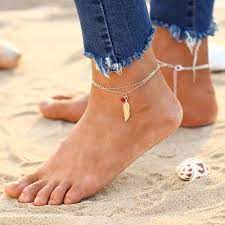Why ladies wear waist beads By Taiye Olayemi
Anklet, also known as ankle chain, ankle bracelet or ankle string is an ornament worn around the ankle; it could also be in form of stringed beads.
Anklets historically have been worn for over 8,000 years by girls and women in South Asia. They have also been worn by Egyptian women since predynastic times.
In the US of America both casual and more formal anklets became fashionable from the 1930s to the late 21st century, while in the western popular culture both younger men and women may wear casual anklets, especially among barefoot women.
Waist beads or chain, on the other hand, is also a type of body jewelry worn around the waist.
The use of waist chains can be traced back to 4,000 years or more, originating in the Indian subcontinent. Historically, waist chains have been used in India, by men and women, as ornaments and as part of religious ceremonies, as accessories and to show affluence.
Female’s legs on wavy sea sand texture background. Woman’s feet with beach bracelets on ankle walking on desert seashore.
With the full understanding of what waist chains and anklets are, it is observed that these were used as body ornaments as against the motive for the usage among the youths currently.
On the contrary, the society has attached negativity to wearing of anklets and waist beads, as they stigmatise those who wear them as “prostitutes”.
Many Nigerians now believe that anklets and waist beads are used as bait to permanently gain the attention of men. Some others have the belief that these materials most often times have been exposed to some rituals before being worn.


In separate interviews with some notable Nigerians, it is observed that anklets and waist beads are majorly used as fashion statements and a means of recognition.
Chief Olusegun Elegunshi, National Chairman, Association of African Traditional Religion of Nigeria (AATREN), clarified that anklets are traditionally worn mainly to differentiate a group of people from the other.
Elegunshi said that the colour of beads stringed on a particular anklet worn by an individual dictates the deity such individual is devoted to, as the devotees of Sango wear red, those of Osun wear white.
He urged Nigerians to learn about each of the deities in their communities, so they don’t continue to act in ignorance.
“Nigerians need to know more about the essence of wearing these anklets and waist beads. In Yoruba land and as a traditionalist, I make bold to say that anklets and waist beads are majorly worn for recognition and fashion.
“For the devotees of Osun, you will see they wear white beads, for the Sango devotees they wear red beads,” he said.
Similarly, Samuel Ajao, Descendant of the Asinde-Made of Ile-Ife, the lineage of Ooni crown makers, said the society must desist from perceiving those wearing anklets and waist beads as prostitutes but rather encourage them because they are only enlivening culture.
Ajao, a graduate of Local Government and Business Administration who has been making crowns for notable kings using beads from childhood, says that the use of beads generally either as a crown, necklace, anklet or waist bead is all about promoting African culture.
He says anklets are worn during chieftaincy ceremonies, while the waist beads are worn for fashion.
He explained that different kinds of beads like Iyun baba ileke, shegi, ateyun and more can be used for string anklets and waist beads.
“Any ornament that is made with beads should be encouraged because beads are our symbol of identity as Africans. Waist beads and anklets are majorly for fashion and should not be seen as being fetish,” he said.
Also, Yeye Omisewa of Ara-Ife, Yeye Anthonia Omowole, explains that anklets are majorly worn by devotees of some deities. Those of Oya wear colour yellow, Obatala, Osun, Olokun, wear white, and those for Sango wear red.
Omowole said that the anklets are also used as symbol of recognition to identify the deities which individuals who wear them are devoted to, just as members of some organisations wear Insignia to show they are members.
According to her, the number of strands of anklet worn by a devotee of a particular deity signifies the wealth of knowledge and experience of the devotee.
She says some waist beads are also used as contraceptive device to prevent unwanted pregnancies, which is called “Jigida”.
Omowole explained that this is used as an alternative means of family planning.
“In African culture, wearing waist beads and anklets do not signify prostitution but beauty. This is also known as a sign of honour, used for recognition and fashion,” she said.
Omowole urged parents to allow their children learn and understand more of the African tradition and culture, which would be of great benefit for them in the future.
Esther Ujah, a Theatre Arts student from Alex Ekwueme University, Abakaliki, Ebonyi State, said she loves to wear waist beads just because of the beauty it gives to her waistline.
“I love the sight of it and the beauty it gives to my waistline and secondly, it helps me regulate my weight. To know when am increasing and reducing in weight,” she said.
According to Oyinkansola Bakare, Chief Executive Officer, Morennikky Stores, waist beads are generally for beauty, as most ladies believe it helps to control body weight.
Bakare said some other ladies also use it to attract the opposite sex because of the beauty it exudes.
Why ladies wear waist beads/NAN






















